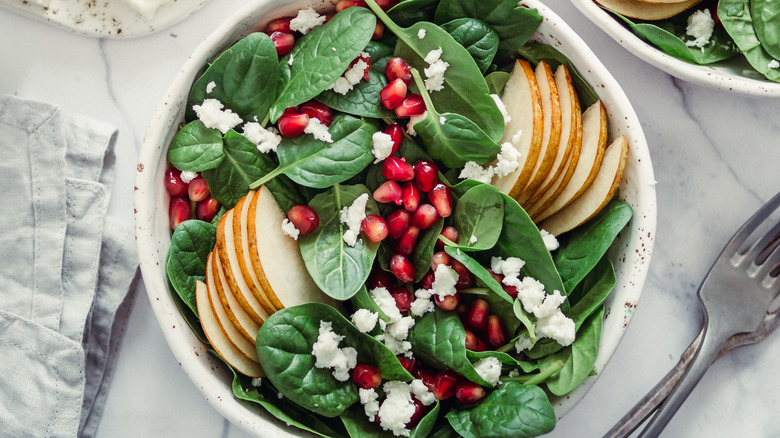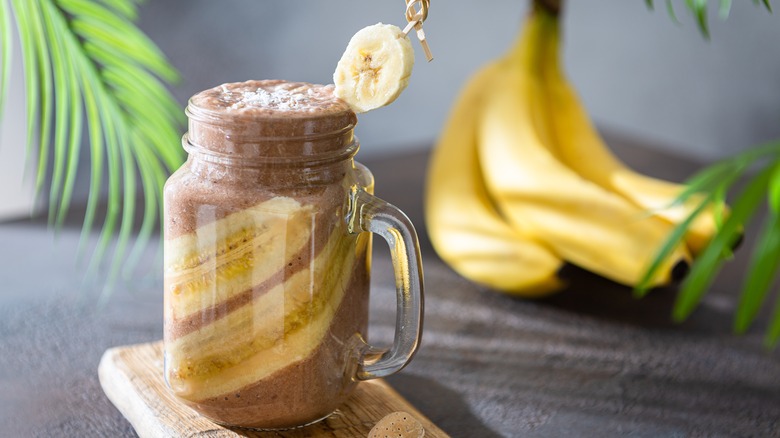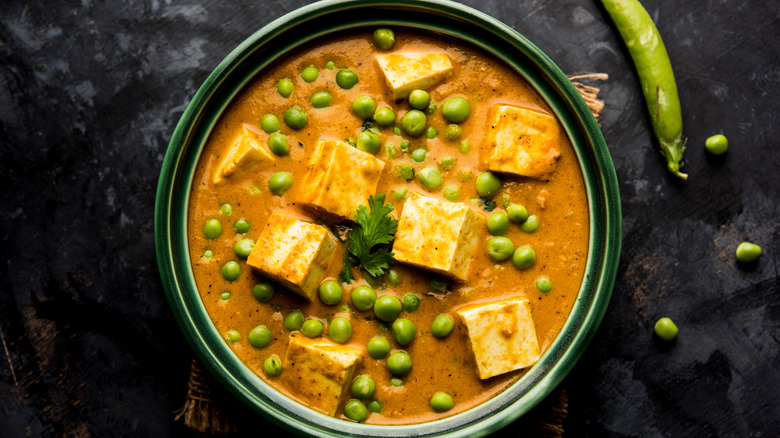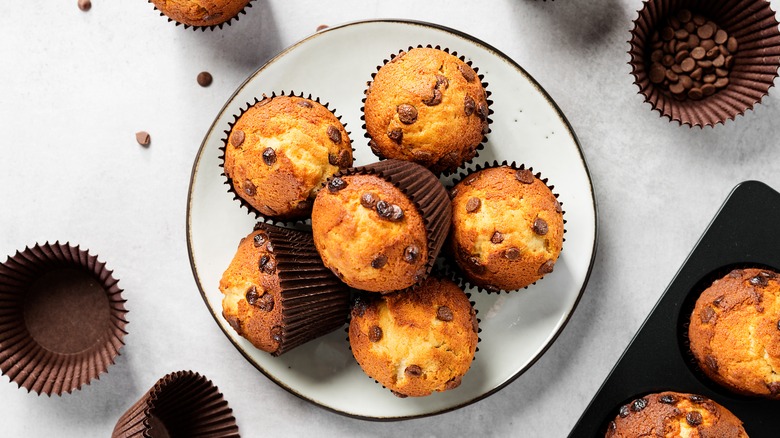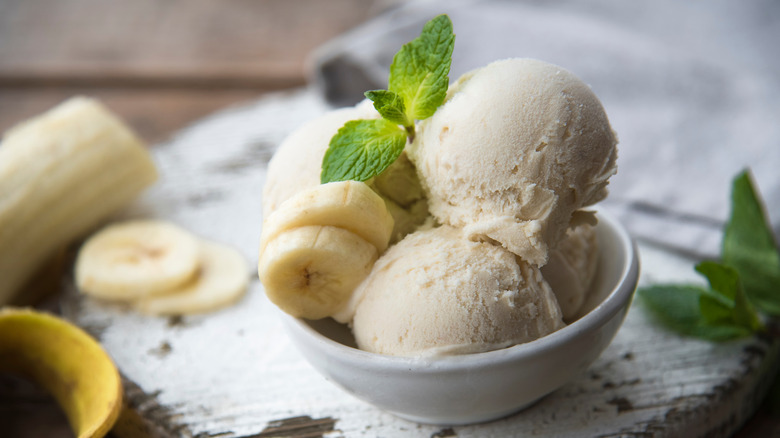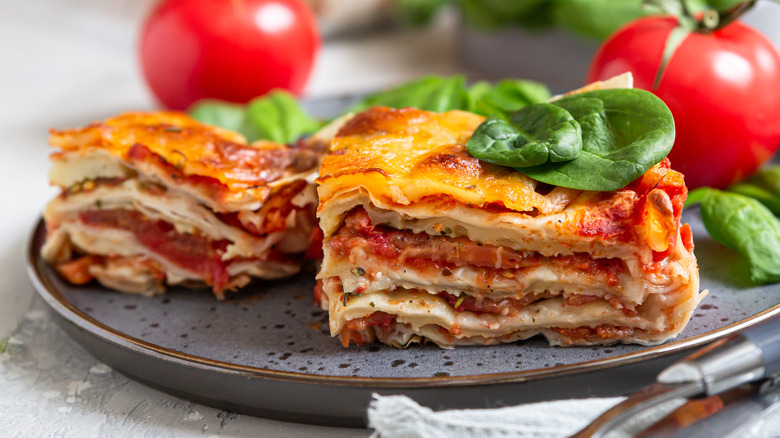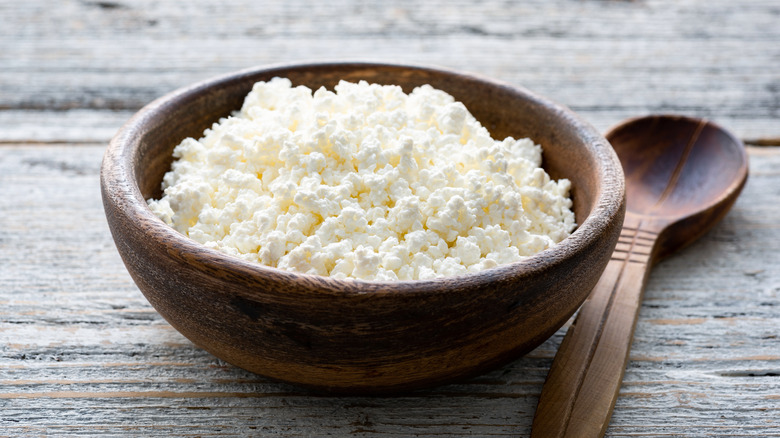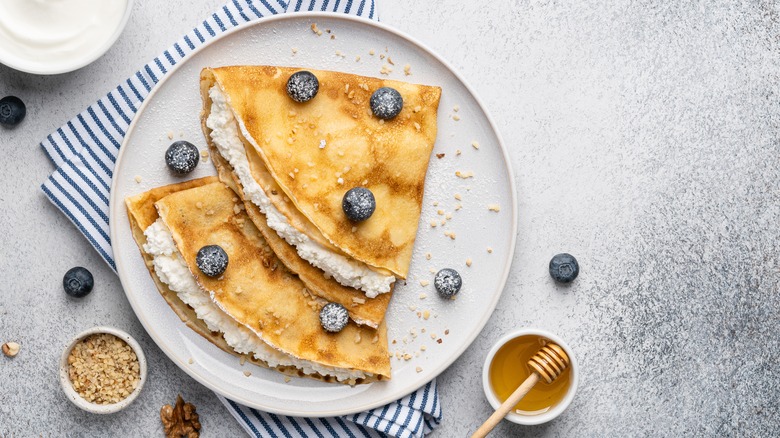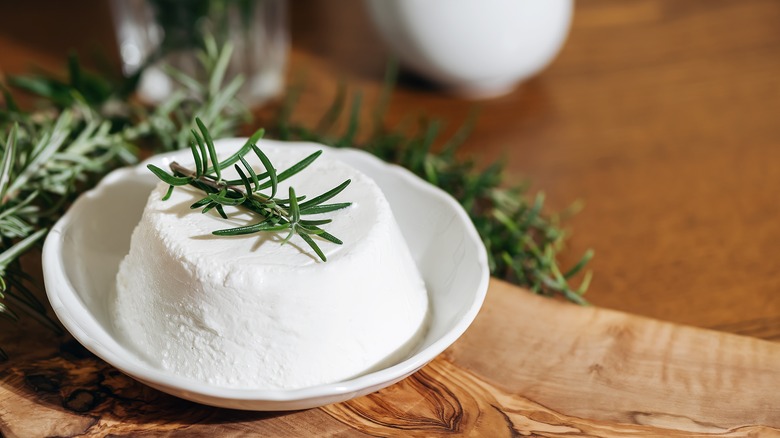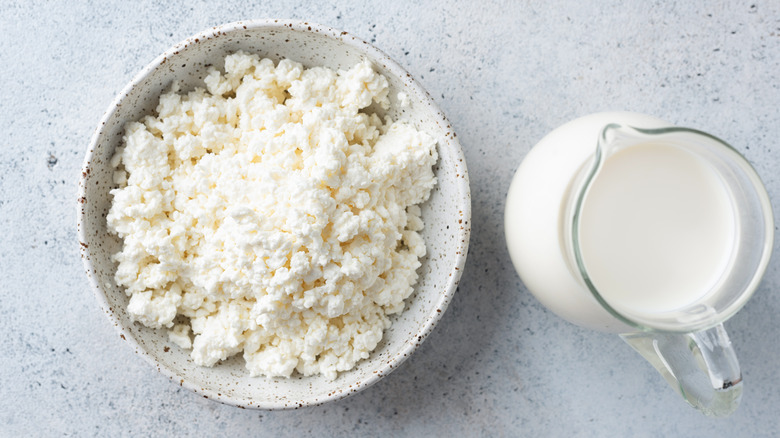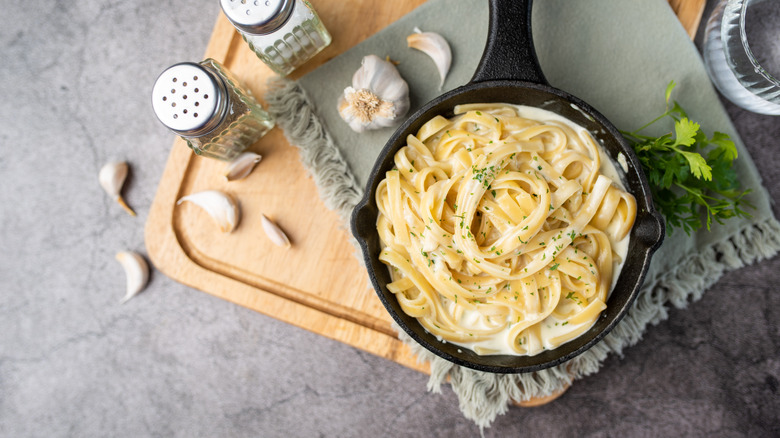12 Tips You Need When Cooking With Cottage Cheese
The oldest American-made cheese also carries the unfortunate reputation for being one of its worst cheeses. Cottage cheese is fresh, mild-flavored with subtle acidity, and composed of bunches of little curds. It tastes like a bygone era that faded away with the advent of color television. At a glance, cottage cheese can easily be mistaken for ricotta or feta cheese, which are similarly curd-ish. During its heyday, it was a go-to topping for fruits and salads, a leavening agent in baking, and the perfect pairing for many other cheese-centric applications. Cottage cheese became popular as a healthier option, helping it to peak during the 1970s. For reasons unknown, in subsequent years, the demand for it began to decrease.
Although it isn't the coolest curd, rumor mill gossip says it's been experiencing somewhat of a resurgence. In fact, findings from a recent Statista study say that over 162 million Americans enjoyed cottage cheese in 2020. The surprising bump may not actually be surprising at all. Cottage cheese is a versatile topping that lends itself to no shortage of delicious applications. From savory to sweet, fresh-served to baked goods, no one cheese should have all that power.
Since the cottage cheese train has already left the station, we wanted to share some necessary cooking tips that'll ensure you catch it at the next stop. Whether a longtime fan or a new kid on the cheese block, cottage cheese is the unlikely ingredient you need to add to your rotation.
1. Give salads a savory sprinkle with cottage cheese
Cheese and salads go together like ketchup and fries, and the cottage variety is no different. The subtle bitter and savory taste of cottage cheese blended into a crisp lettuce mixture is perfect for your spring and summer gatherings. When introduced to a bed of leafy greens, cottage cheese takes on the role of salad dressing, reducing how much actual dressing you need to use. It can also substitute it completely, boosting your salad's nutrients with its various health benefits.
There's no doubt about it — if you're a salad-lover, cottage cheese will add just the extra delicious kick you didn't know you craved. Pair savory steak with cottage cheese-infused cucumber and dill pasta salad, or offer dinner guests a peculiar blast from the past with Jell-O salad, the retro dessert trend that evolved to also include cottage cheese. From leafy salads to pasta, you'll never run out of tasty options to top with cottage cheese; it's even considered one of the absolute best cheeses to add to your tuna salad.
2. Blend cottage cheese into a refreshing smoothie bowl
Cottage cheese is a surprisingly versatile ingredient. Along with savory foods, it is also a useful addition to sweet treats. One unlikely use for cottage cheese is as a yogurt substitute for smoothies. Yogurt is a popular smoothie enhancer because it plays the background, rather than overwhelming the flavor. Its subtle tanginess and extra creaminess give smoothies a more pleasant mouthfeel. Another thing that's great about yogurt is that it has probiotic qualities that help to maintain gut health.
Cottage cheese happens to offer similar benefits as yogurt. As a proven fruit topper, it fits right in with common smoothie flavors. Also like yogurt, cottage cheese is packed with health-supporting benefits which include high calcium and vitamin A, protein richness, and low calories. While one of yogurt's main benefits is probiotic qualities, cottage cheese — which is fermented and cultured — offers the same tummy love. Not to worry about the curdy texture of cottage cheese either, because a few rotations in the blender will turn it to mush in no time.
Drop a few dollops of cottage cheese into a refreshing mango banana smoothie recipe for a boost of goodness, or marry the tang with the aromatic by blending some into this strawberry cinnamon smoothie recipe.
3. Spruce up cheesy soups with a healthier option
The hearty remedy for a chilly day, soup is hands down one of the most versatile foods available. There's literally no limit to the ingredients you can add to your soup, and one of the best ways to spruce things up is with cheese. While cheddar and mozzarella varieties are common melty go-tos, cottage cheese is the unlikely perfect complement to your cozy cure. It carries a mild touch and blends seamlessly while rounding out the consistency. As a fresh cheese, you won't achieve the silky melt of cheddar, but hot soup will certainly reduce the cheese curds into a pleasantly creamy mouthfeel.
You'll find an endless selection of soups to try cottage cheese with. Keep it cheesy and classic with this broccoli cheddar soup recipe, or unload a few spoonfuls into a summery caldo de queso soup. If you're in the mood for a recipe that's filling and fun, use cottage cheese mixed with milk in place of the whipped cream used in this loaded cheeseburger soup. Whatever signals your stomach sends, there's a soup that's tasty and cottage cheese-friendly. Simply put, cottage cheese just might be the secret ingredient to make your soup "soup-er."
4. Dip cheesy Dorito chips into cottage cheese
When your cheese cravings are getting the best of you, a bag of nacho cheese Doritos is guaranteed to put a smile on your face. Their rich cheesy flavor is only matched by their satisfying crunch, and subsequent residue left behind on your fingers. Despite having all the delicious makings of a flavor bomb, Doritos are paired with savory dips almost as often as they're enjoyed solo. Our love for cheese is written in history books, which might explain why we enjoy dipping nacho cheese Doritos into queso. What better topping for cheese than, well, more cheese?
Just ask Dan Van Rite, co-owner and executive chef of two cutting-edge Milwaukee-based restaurants. Van Rite's guilty pleasure is a curious combo of Doritos and the curdy subject of this piece: cottage cheese. See guys? Even master chefs get the munchies for odd snack pairings. He grew up eating cottage cheese when it was more popular and one day discovered how addictive pairing it with Doritos is. As a chef-approved combo, we definitely recommend giving it a try.
5. Cottage cheese gives baked goods extra fluff
As cottage cheese continues its resurgence, we recommend using it for baking. Much like yogurt, ricotta, and sour cream varieties, cottage cheese adds flavor and provides the fat needed to achieve tender and flaky results. As previously mentioned, cottage cheese is a fresh cheese, which means it's composed of curds. When baking, those little curds will add texture to the dough and give it a dynamic consistency. The tiny curds brown inside the oven, leaving small bumps in the pastry that beg to be bitten. We recommended using full-fat cottage cheese with small curds rather than the kind with big lumps.
One of several fermented foods you can cook with, cottage cheese is also one of the best-kept baking secrets. The first step is to decide which type of cottage cheese your recipe needs — dry or creamy. If you're looking to increase moisture in breads, creamy cottage cheese is best, while the dry kind is best for baking at high temperatures, but is also harder to find. If you happen to have a hard time finding dry cottage cheese, one workaround is to strain the creamy kind. It helps baked goods lift, providing an airiness to the dough, unlike sour cream and cream cheese, which offer more dense results.
6. Only three ingredients makes cottage cheese ice cream
Not only is the food scene reacquainting itself with all the tried and true ways to enjoy cottage cheese, but new flavor combinations are also being created. For example, whatever dessert mastermind that invented cottage cheese ice cream sure had some curd. Cottage cheese ice cream is a bizarre recipe that started as a viral TikTok sensation before becoming a summertime must-have. Admittedly, at first, the concept of blending cottage cheese into ice cream seems as like to turn stomachs as it does heads. Yet the viral video's millions of views are evidence that folks are more curious than not.
Cottage cheese plays a similar role here that it does when used in other recipes. Its mild-flavored taste is masked by the richness of ice cream, which means that there's almost limitless potential for flavor combinations. To start, all you need is three additional ingredients: whole-fat cottage cheese, a sweetener, and your choice of fruit and cookie bits. For fruit, try ripe and fresh strawberries, peaches, or pomegranates. If cookie crumbles aren't your cup of tea, you can substitute them with graham crackers or your favorite granola mix. All you need is an immersion blender, a cottage cheese container for freezing, and a wee bit of patience.
7. Amp up the deliciousness of your lasagna
When it comes to foods that take forever to prepare, lasagna sits comfortably on the list of the most patience-testing dishes. Let's face it, there are few greater creations than lasagna's layered brilliance — its mouthwatering smell alone can lift you from your seat. The Italian comfort staple is composed of only a few ingredients: pasta noodles, sauce, your choice of meat or veggies, and a blend of melted cheeses. What makes it even better is that you're more than welcome to take liberty with the specific types of each ingredient. While popular cheese choices like mozzarella, cheddar, or gouda are surefire go-tos, the versatility of lasagna's base ingredients also allows for a nontraditional option like cottage cheese.
The less-popular ricotta, cottage cheese has a similar texture that makes it an excellent fresh cheese alternative. We suggest making a savory béchamel sauce using it mixed with heavy cream and Pecorino Romano. It's a well-rounded cheesy sauce that's super easy to make. Its light and creamy taste compliments the full-bodied flavor of lasagna, allowing you to eat more deliciousness, which is either a good thing ... or a great thing. Cottage cheese-infused sauce will satisfy your cheese cravings without overdoing it with calories and fat. In other words, it's hearty and healthy.
8. Use as a healthier alternative to sour cream
The best, but sometimes saddest, part about cheese is that the tastiest types are often the least nutritious for you. Although you must appreciate the artisanal flare of a well-crafted cheese board, licking cheesy dust from your fingertips is equally if not more enjoyable. Such is the shaky relationship with cheese — it can be deadly delicious, which is to say that moderation is key. Take sour cream, for example — its mild yet tangy kick is a refreshing addition to many dishes, yet it's loaded with more than twice as many calories as cottage cheese.
If decreasing your caloric intake doesn't pique your interest, maybe the lower saturated fat content and protein punch will. Compared to sour cream, a half cup of cottage cheese only has a fraction of the fat and nearly four times as much protein. As you can clearly see, cottage cheese is a great sour cream alternative. Baked potatoes are a great recipe to try the sour cream and cottage cheese swap out on. It offers the same fresh and creamy touch, mixing perfectly with traditional toppings like bacon bits, chopped green onions, and smoked paprika. If you think about all the ways to use sour cream, you'll also find many ways to use cottage cheese.
9. Top your breakfast favorites with cottage cheese
From classic scrambles to açai bowls, cottage cheese is the pancake-fluffin', omelet-topping ingredient that makes breakfast better. If you're looking for an enhanced lift, drop some cottage cheese into your pancake mix. As a low-fat type of cheese, it will give your flapjacks a flavorful and nutritious boost. Breakfast bowls are also tasty playgrounds for cottage cheese. You can start the day with an apple cinnamon breakfast bowl that's topped with cottage cheese and includes chopped walnuts. It's similar to a yogurt parfait, yet has the curdy consistency cottage is known for.
If savory is more your flavor, mix some dairy love into a bowl of freshly sliced veggies and hard-boiled eggs. A sprinkle of black pepper and salt to taste and you're good to go. Another recipe that uses cottage cheese as a secret ingredient is scrambled eggs. The curds cook in easily, giving the eggs an extra bit of fluff and feather. Even oats are enhanced by using cottage cheese. For a breakfast worth boasting over, add a bit to your bowl along with sliced bananas, sea salt, cinnamon, and vanilla. With such versatility, start each morning can with a new cottage cheese-infused recipe.
10. Ricotta is sometimes, but not always, an alternative
Although cottage cheese and ricotta are mostly interchangeable ingredients, there is a caveat: texture. Ricotta is thick and creamy while cottage is more grainy with larger curds. While both are considered fresh cheeses, ricotta is made of whey that's extracted from curds during the cheesemaking process. The whey is heated until it congeals into a soft cheese, which is then either salted, aged, or combined with milk for additional creaminess. When it comes down to it, the downside to swapping ricotta with cottage cheese is a matter of preference.
Cottage cheese is ricotta's cousin, also white and soft, yet created using a distinct process. Whereas ricotta is produced from whey, cottage cheese is made from milk-based curds. Depending on your curd craving, there are small, medium, and large curd options. There's a difference in flavor as well. Cottage cheese leans more on the salty side of things while ricotta tends to be sweeter — the salted ricotta salata variety is the exception. Another distinction between the two is cottage cheese's probiotic and health-supporting properties. Along with being lower in fat, cholesterol, and calories, it's vitamin-dense, making it easily the healthier choice. Ricotta does beat cottage when it comes to carbs, though. When it all melts down to it, both cheeses are delicious. It really depends on the recipe and personal taste.
11. Cottage cheese is nutrient and protein-rich
By now you've learned about cottage cheese's health benefits. During the height of its popularity, one of the main reasons people took a liking to it was because it's a diet-friendly cheese. It's not only packed with calcium, but it also helps prevent anemia with an excellent boost of vitamin B12, and others like potassium, phosphorus, selenium, and vitamin A. Adding density to its list of nutrients, one cup of cottage cheese has 185 calories, 25 grams of protein, and 11 grams of carbohydrates.
Cottage cheese is a popular choice for nutrient-rich diets, its arsenal of benefits includes blood sugar management, muscle recovery, and thyroid health. It's a great low-fat and sugar option and helps increase your metabolism, improving muscle recovery. Another highlight of its health benefits is selenium, a trace mineral that's important for thyroid health. Nutritiousness aside, cottage cheese isn't all curds and cream. Some varieties actually pack a decent amount of saturated fats and calories. It's important to check out the ingredients and make sure you're purchasing a quality brand. Some brands nowadays even offer probiotics that help balance out your tummy.
12. Mix cottage cheese with evaporated milk for pasta
You'll want to slurp up a forkful of this uncommon combo. Cottage cheese is the creamy component you didn't know your pasta needed. By no means is the love affair between cheese and pasta new, yet cottage cheese rarely, if ever, is included in the convo. It's understandable, as it only offers a mild taste and the curdy texture might be unappealing for some. But, before you jump ship on the idea of putting cottage cheese in pasta, not only is it a protein-rich and lower-calorie alternative, but when mixed with evaporated milk, it can be whipped up into a mean pasta sauce.
The mildly salty taste of cottage cheese actually makes it a great pairing ingredient. It's basically a blank cheesy canvas that you can paint with flavors. In pasta, you can substitute Alfredo with cottage cheese. It's a more than suitable base for a rich and creamy white sauce. You'll need to grab a food processor and blend those curds with evaporated milk and pasta water. The starch from the pasta water will help the sauce achieve a savory and silky consistency. After you've got the sauce, you can flavor it with traditional Alfredo seasoning like chopped garlic, aromatic Italian seasoning, black pepper, and of course, a little butter never hurts.

